Leadership and Management for Service Industries: Hilton Report
VerifiedAdded on 2023/01/12
|10
|2336
|46
Report
AI Summary
This report delves into the critical roles of leadership and management within the service industry, using Hilton Hotels as a case study. It examines the importance of leadership and management in achieving organizational goals, focusing on how they facilitate employee performance and resource utilization. The report explores Hilton's organizational structure, culture, and the application of classical management theories. It analyzes various leadership styles, including democratic and transformational approaches, and their impact on employee engagement and customer satisfaction. Furthermore, it identifies and discusses the challenges and obstacles managers and leaders face in talent management, such as communication barriers, talent retention, and employee motivation. The influence of internal and external factors on management styles and structures is also considered, along with the impact of talent management challenges on leadership styles. The report concludes by highlighting the significance of adapting leadership approaches to foster a positive work environment and improve overall organizational performance.
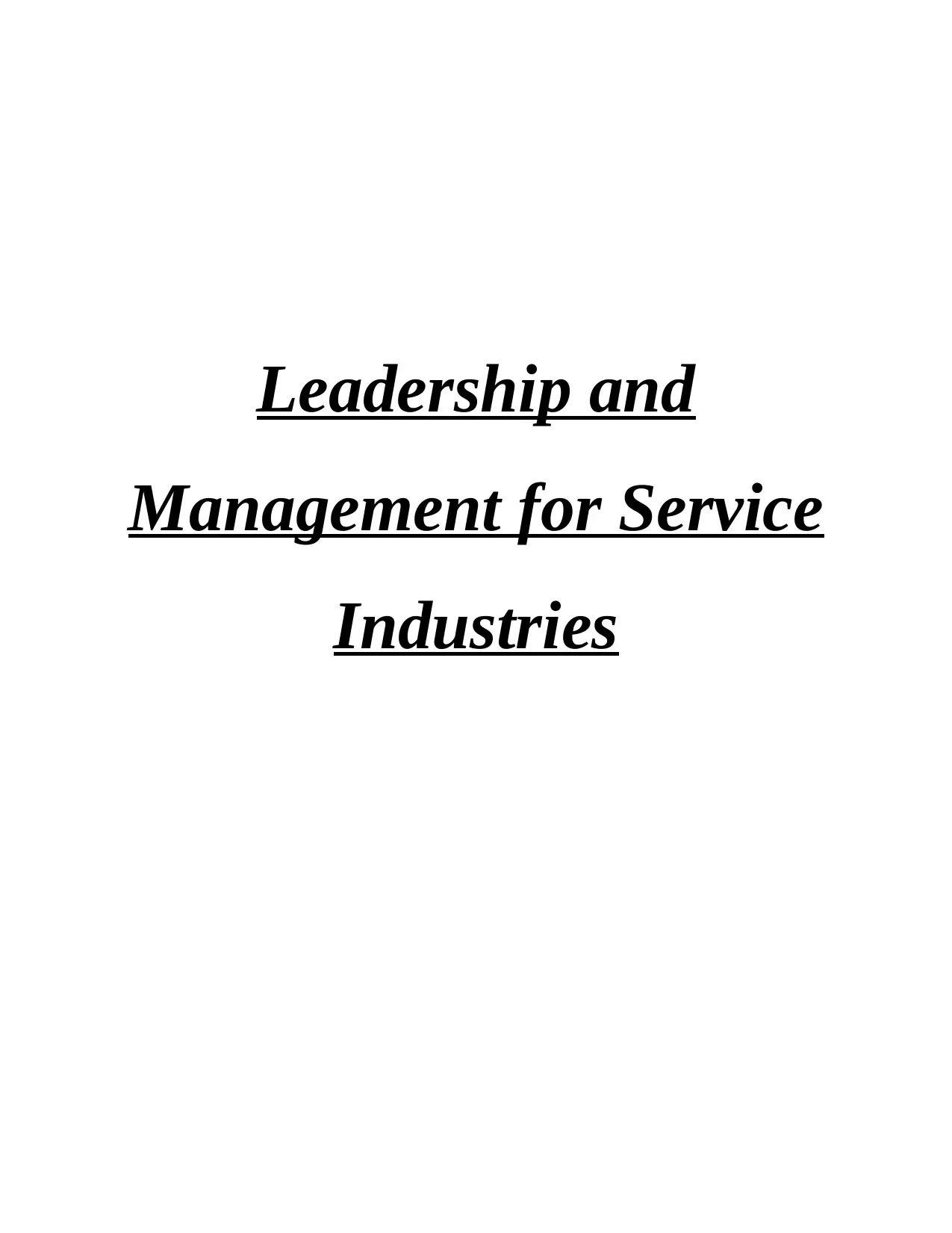
Leadership and
Management for Service
Industries
Management for Service
Industries
Paraphrase This Document
Need a fresh take? Get an instant paraphrase of this document with our AI Paraphraser
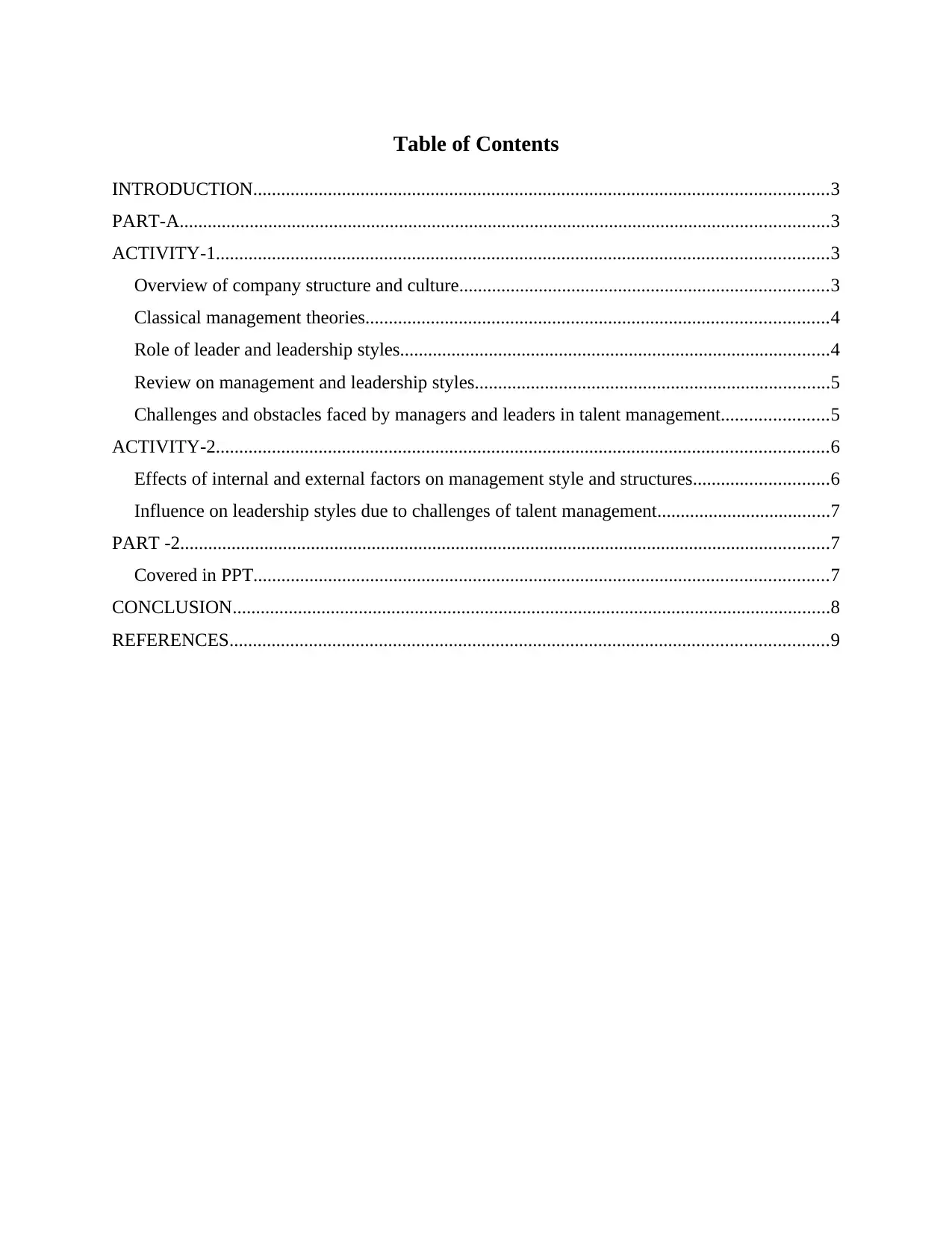
Table of Contents
INTRODUCTION...........................................................................................................................3
PART-A...........................................................................................................................................3
ACTIVITY-1...................................................................................................................................3
Overview of company structure and culture...............................................................................3
Classical management theories...................................................................................................4
Role of leader and leadership styles............................................................................................4
Review on management and leadership styles............................................................................5
Challenges and obstacles faced by managers and leaders in talent management.......................5
ACTIVITY-2...................................................................................................................................6
Effects of internal and external factors on management style and structures.............................6
Influence on leadership styles due to challenges of talent management.....................................7
PART -2...........................................................................................................................................7
Covered in PPT...........................................................................................................................7
CONCLUSION................................................................................................................................8
REFERENCES................................................................................................................................9
INTRODUCTION...........................................................................................................................3
PART-A...........................................................................................................................................3
ACTIVITY-1...................................................................................................................................3
Overview of company structure and culture...............................................................................3
Classical management theories...................................................................................................4
Role of leader and leadership styles............................................................................................4
Review on management and leadership styles............................................................................5
Challenges and obstacles faced by managers and leaders in talent management.......................5
ACTIVITY-2...................................................................................................................................6
Effects of internal and external factors on management style and structures.............................6
Influence on leadership styles due to challenges of talent management.....................................7
PART -2...........................................................................................................................................7
Covered in PPT...........................................................................................................................7
CONCLUSION................................................................................................................................8
REFERENCES................................................................................................................................9
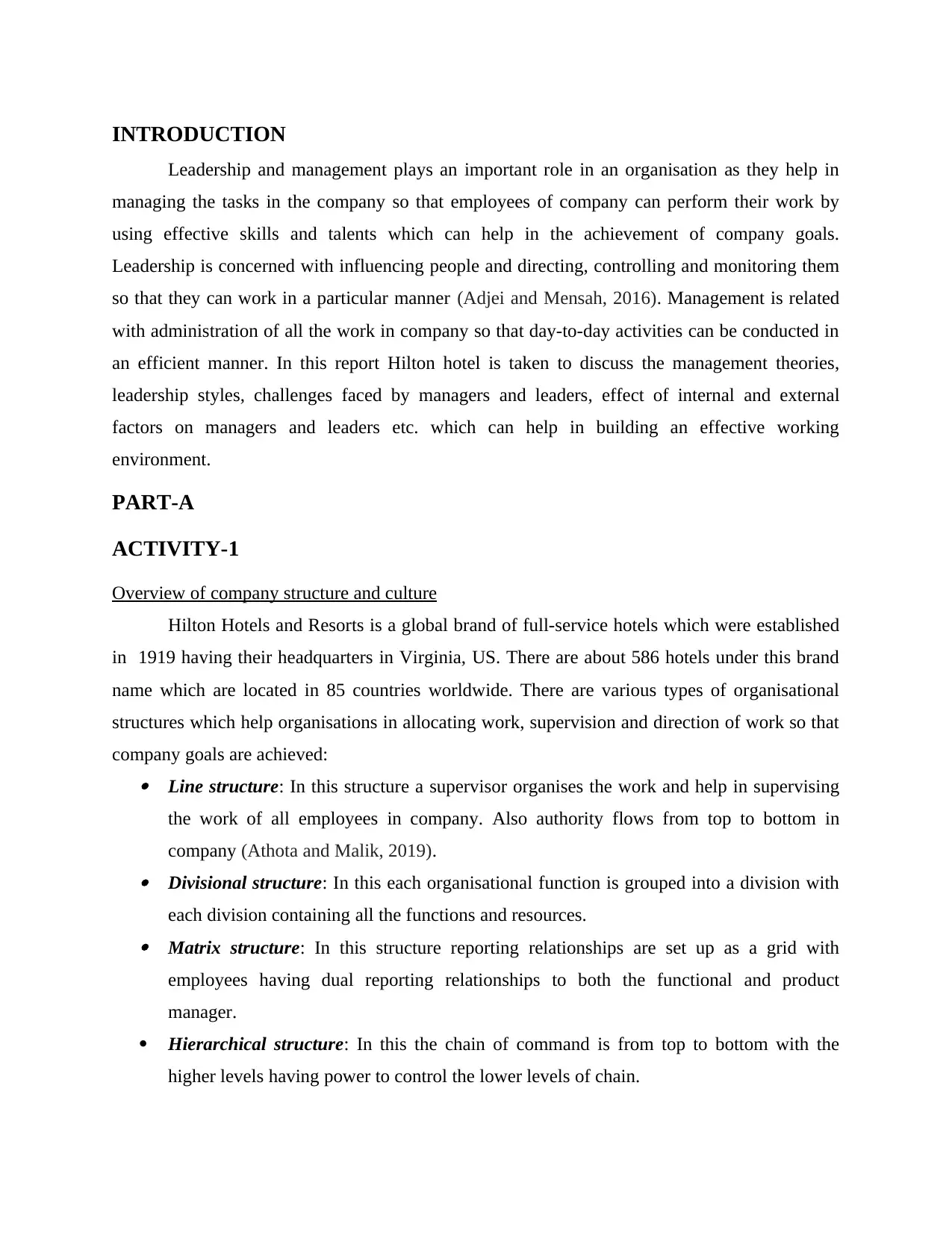
INTRODUCTION
Leadership and management plays an important role in an organisation as they help in
managing the tasks in the company so that employees of company can perform their work by
using effective skills and talents which can help in the achievement of company goals.
Leadership is concerned with influencing people and directing, controlling and monitoring them
so that they can work in a particular manner (Adjei and Mensah, 2016). Management is related
with administration of all the work in company so that day-to-day activities can be conducted in
an efficient manner. In this report Hilton hotel is taken to discuss the management theories,
leadership styles, challenges faced by managers and leaders, effect of internal and external
factors on managers and leaders etc. which can help in building an effective working
environment.
PART-A
ACTIVITY-1
Overview of company structure and culture
Hilton Hotels and Resorts is a global brand of full-service hotels which were established
in 1919 having their headquarters in Virginia, US. There are about 586 hotels under this brand
name which are located in 85 countries worldwide. There are various types of organisational
structures which help organisations in allocating work, supervision and direction of work so that
company goals are achieved: Line structure: In this structure a supervisor organises the work and help in supervising
the work of all employees in company. Also authority flows from top to bottom in
company (Athota and Malik, 2019). Divisional structure: In this each organisational function is grouped into a division with
each division containing all the functions and resources. Matrix structure: In this structure reporting relationships are set up as a grid with
employees having dual reporting relationships to both the functional and product
manager.
Hierarchical structure: In this the chain of command is from top to bottom with the
higher levels having power to control the lower levels of chain.
Leadership and management plays an important role in an organisation as they help in
managing the tasks in the company so that employees of company can perform their work by
using effective skills and talents which can help in the achievement of company goals.
Leadership is concerned with influencing people and directing, controlling and monitoring them
so that they can work in a particular manner (Adjei and Mensah, 2016). Management is related
with administration of all the work in company so that day-to-day activities can be conducted in
an efficient manner. In this report Hilton hotel is taken to discuss the management theories,
leadership styles, challenges faced by managers and leaders, effect of internal and external
factors on managers and leaders etc. which can help in building an effective working
environment.
PART-A
ACTIVITY-1
Overview of company structure and culture
Hilton Hotels and Resorts is a global brand of full-service hotels which were established
in 1919 having their headquarters in Virginia, US. There are about 586 hotels under this brand
name which are located in 85 countries worldwide. There are various types of organisational
structures which help organisations in allocating work, supervision and direction of work so that
company goals are achieved: Line structure: In this structure a supervisor organises the work and help in supervising
the work of all employees in company. Also authority flows from top to bottom in
company (Athota and Malik, 2019). Divisional structure: In this each organisational function is grouped into a division with
each division containing all the functions and resources. Matrix structure: In this structure reporting relationships are set up as a grid with
employees having dual reporting relationships to both the functional and product
manager.
Hierarchical structure: In this the chain of command is from top to bottom with the
higher levels having power to control the lower levels of chain.
⊘ This is a preview!⊘
Do you want full access?
Subscribe today to unlock all pages.

Trusted by 1+ million students worldwide
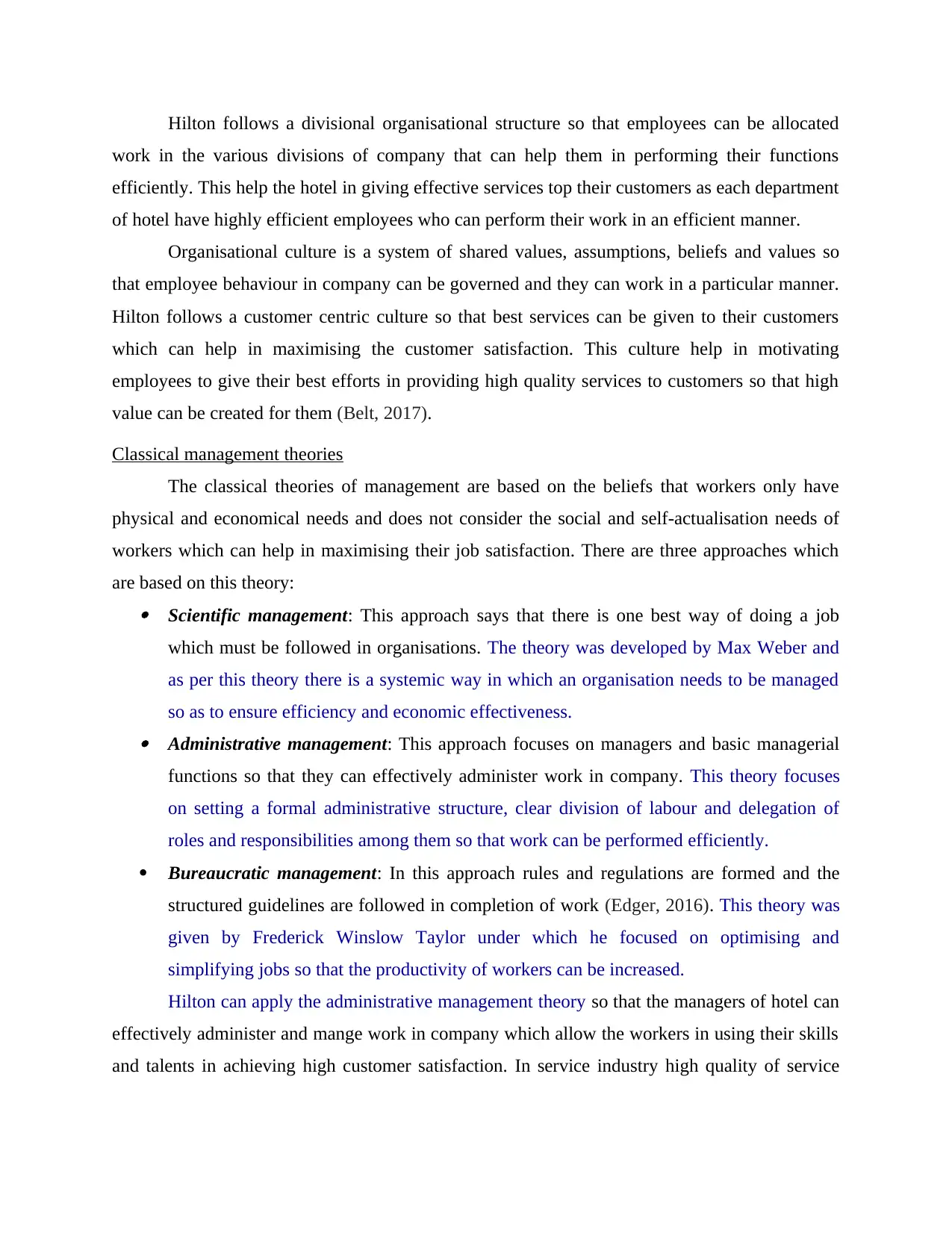
Hilton follows a divisional organisational structure so that employees can be allocated
work in the various divisions of company that can help them in performing their functions
efficiently. This help the hotel in giving effective services top their customers as each department
of hotel have highly efficient employees who can perform their work in an efficient manner.
Organisational culture is a system of shared values, assumptions, beliefs and values so
that employee behaviour in company can be governed and they can work in a particular manner.
Hilton follows a customer centric culture so that best services can be given to their customers
which can help in maximising the customer satisfaction. This culture help in motivating
employees to give their best efforts in providing high quality services to customers so that high
value can be created for them (Belt, 2017).
Classical management theories
The classical theories of management are based on the beliefs that workers only have
physical and economical needs and does not consider the social and self-actualisation needs of
workers which can help in maximising their job satisfaction. There are three approaches which
are based on this theory: Scientific management: This approach says that there is one best way of doing a job
which must be followed in organisations. The theory was developed by Max Weber and
as per this theory there is a systemic way in which an organisation needs to be managed
so as to ensure efficiency and economic effectiveness. Administrative management: This approach focuses on managers and basic managerial
functions so that they can effectively administer work in company. This theory focuses
on setting a formal administrative structure, clear division of labour and delegation of
roles and responsibilities among them so that work can be performed efficiently.
Bureaucratic management: In this approach rules and regulations are formed and the
structured guidelines are followed in completion of work (Edger, 2016). This theory was
given by Frederick Winslow Taylor under which he focused on optimising and
simplifying jobs so that the productivity of workers can be increased.
Hilton can apply the administrative management theory so that the managers of hotel can
effectively administer and mange work in company which allow the workers in using their skills
and talents in achieving high customer satisfaction. In service industry high quality of service
work in the various divisions of company that can help them in performing their functions
efficiently. This help the hotel in giving effective services top their customers as each department
of hotel have highly efficient employees who can perform their work in an efficient manner.
Organisational culture is a system of shared values, assumptions, beliefs and values so
that employee behaviour in company can be governed and they can work in a particular manner.
Hilton follows a customer centric culture so that best services can be given to their customers
which can help in maximising the customer satisfaction. This culture help in motivating
employees to give their best efforts in providing high quality services to customers so that high
value can be created for them (Belt, 2017).
Classical management theories
The classical theories of management are based on the beliefs that workers only have
physical and economical needs and does not consider the social and self-actualisation needs of
workers which can help in maximising their job satisfaction. There are three approaches which
are based on this theory: Scientific management: This approach says that there is one best way of doing a job
which must be followed in organisations. The theory was developed by Max Weber and
as per this theory there is a systemic way in which an organisation needs to be managed
so as to ensure efficiency and economic effectiveness. Administrative management: This approach focuses on managers and basic managerial
functions so that they can effectively administer work in company. This theory focuses
on setting a formal administrative structure, clear division of labour and delegation of
roles and responsibilities among them so that work can be performed efficiently.
Bureaucratic management: In this approach rules and regulations are formed and the
structured guidelines are followed in completion of work (Edger, 2016). This theory was
given by Frederick Winslow Taylor under which he focused on optimising and
simplifying jobs so that the productivity of workers can be increased.
Hilton can apply the administrative management theory so that the managers of hotel can
effectively administer and mange work in company which allow the workers in using their skills
and talents in achieving high customer satisfaction. In service industry high quality of service
Paraphrase This Document
Need a fresh take? Get an instant paraphrase of this document with our AI Paraphraser
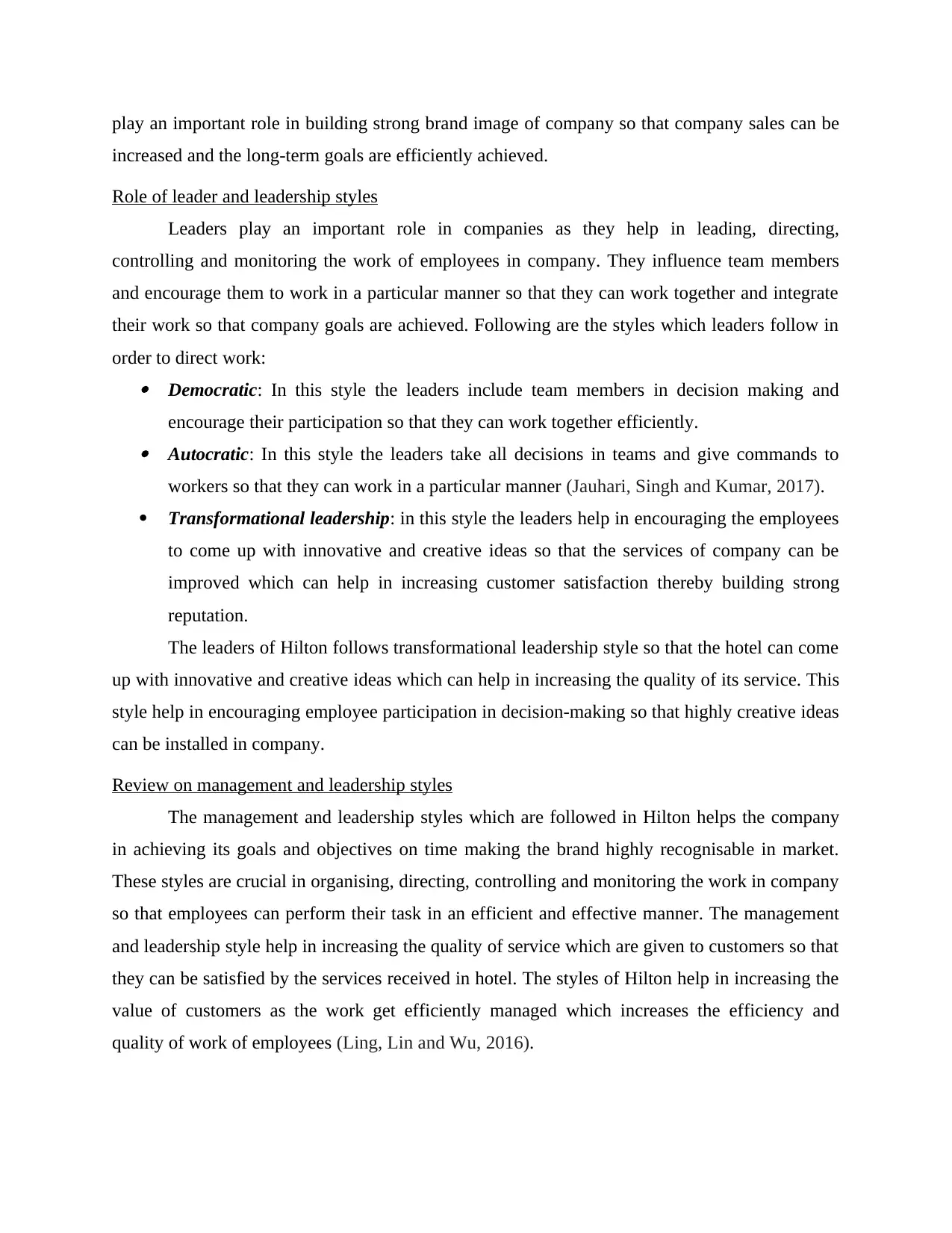
play an important role in building strong brand image of company so that company sales can be
increased and the long-term goals are efficiently achieved.
Role of leader and leadership styles
Leaders play an important role in companies as they help in leading, directing,
controlling and monitoring the work of employees in company. They influence team members
and encourage them to work in a particular manner so that they can work together and integrate
their work so that company goals are achieved. Following are the styles which leaders follow in
order to direct work: Democratic: In this style the leaders include team members in decision making and
encourage their participation so that they can work together efficiently. Autocratic: In this style the leaders take all decisions in teams and give commands to
workers so that they can work in a particular manner (Jauhari, Singh and Kumar, 2017).
Transformational leadership: in this style the leaders help in encouraging the employees
to come up with innovative and creative ideas so that the services of company can be
improved which can help in increasing customer satisfaction thereby building strong
reputation.
The leaders of Hilton follows transformational leadership style so that the hotel can come
up with innovative and creative ideas which can help in increasing the quality of its service. This
style help in encouraging employee participation in decision-making so that highly creative ideas
can be installed in company.
Review on management and leadership styles
The management and leadership styles which are followed in Hilton helps the company
in achieving its goals and objectives on time making the brand highly recognisable in market.
These styles are crucial in organising, directing, controlling and monitoring the work in company
so that employees can perform their task in an efficient and effective manner. The management
and leadership style help in increasing the quality of service which are given to customers so that
they can be satisfied by the services received in hotel. The styles of Hilton help in increasing the
value of customers as the work get efficiently managed which increases the efficiency and
quality of work of employees (Ling, Lin and Wu, 2016).
increased and the long-term goals are efficiently achieved.
Role of leader and leadership styles
Leaders play an important role in companies as they help in leading, directing,
controlling and monitoring the work of employees in company. They influence team members
and encourage them to work in a particular manner so that they can work together and integrate
their work so that company goals are achieved. Following are the styles which leaders follow in
order to direct work: Democratic: In this style the leaders include team members in decision making and
encourage their participation so that they can work together efficiently. Autocratic: In this style the leaders take all decisions in teams and give commands to
workers so that they can work in a particular manner (Jauhari, Singh and Kumar, 2017).
Transformational leadership: in this style the leaders help in encouraging the employees
to come up with innovative and creative ideas so that the services of company can be
improved which can help in increasing customer satisfaction thereby building strong
reputation.
The leaders of Hilton follows transformational leadership style so that the hotel can come
up with innovative and creative ideas which can help in increasing the quality of its service. This
style help in encouraging employee participation in decision-making so that highly creative ideas
can be installed in company.
Review on management and leadership styles
The management and leadership styles which are followed in Hilton helps the company
in achieving its goals and objectives on time making the brand highly recognisable in market.
These styles are crucial in organising, directing, controlling and monitoring the work in company
so that employees can perform their task in an efficient and effective manner. The management
and leadership style help in increasing the quality of service which are given to customers so that
they can be satisfied by the services received in hotel. The styles of Hilton help in increasing the
value of customers as the work get efficiently managed which increases the efficiency and
quality of work of employees (Ling, Lin and Wu, 2016).
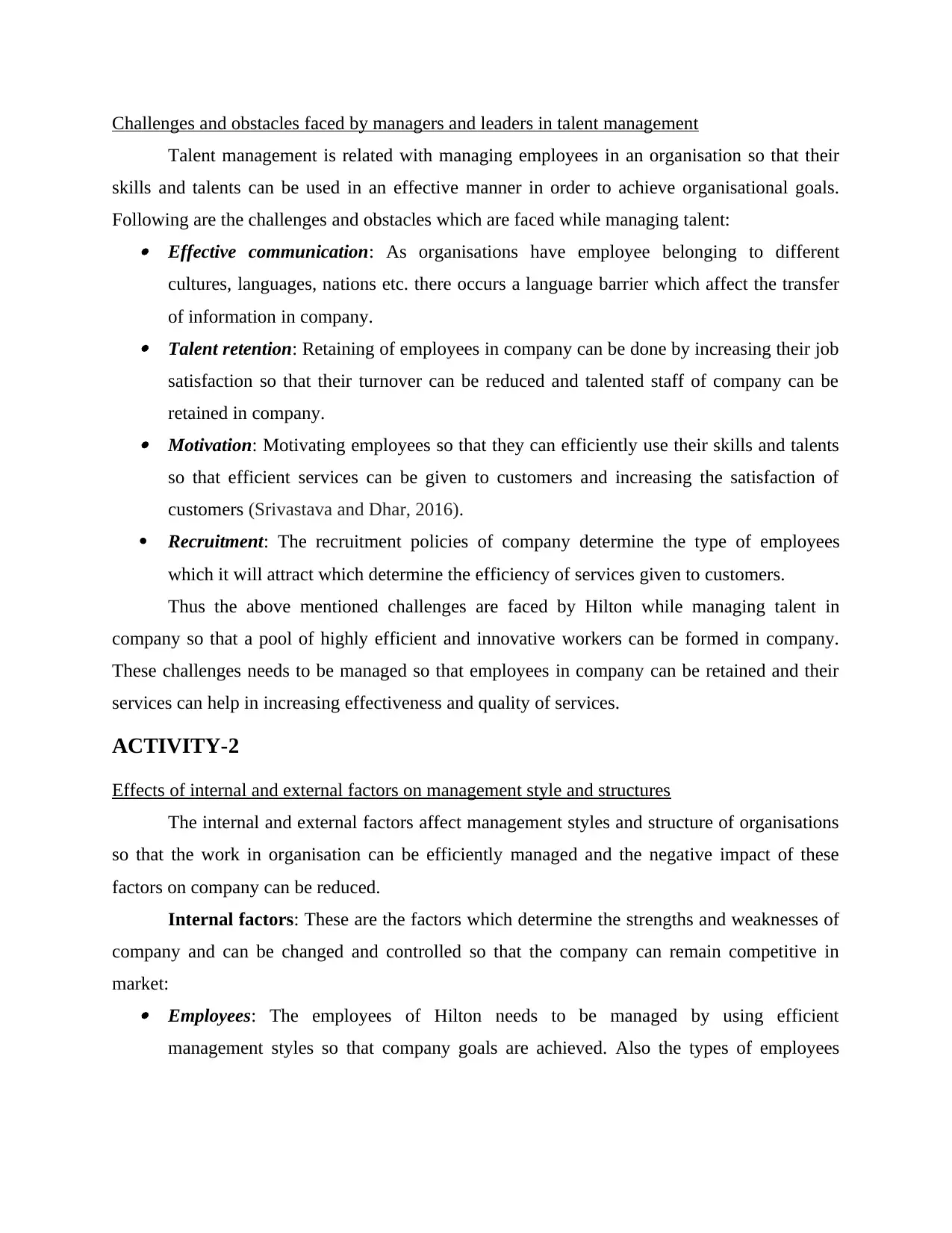
Challenges and obstacles faced by managers and leaders in talent management
Talent management is related with managing employees in an organisation so that their
skills and talents can be used in an effective manner in order to achieve organisational goals.
Following are the challenges and obstacles which are faced while managing talent: Effective communication: As organisations have employee belonging to different
cultures, languages, nations etc. there occurs a language barrier which affect the transfer
of information in company. Talent retention: Retaining of employees in company can be done by increasing their job
satisfaction so that their turnover can be reduced and talented staff of company can be
retained in company. Motivation: Motivating employees so that they can efficiently use their skills and talents
so that efficient services can be given to customers and increasing the satisfaction of
customers (Srivastava and Dhar, 2016).
Recruitment: The recruitment policies of company determine the type of employees
which it will attract which determine the efficiency of services given to customers.
Thus the above mentioned challenges are faced by Hilton while managing talent in
company so that a pool of highly efficient and innovative workers can be formed in company.
These challenges needs to be managed so that employees in company can be retained and their
services can help in increasing effectiveness and quality of services.
ACTIVITY-2
Effects of internal and external factors on management style and structures
The internal and external factors affect management styles and structure of organisations
so that the work in organisation can be efficiently managed and the negative impact of these
factors on company can be reduced.
Internal factors: These are the factors which determine the strengths and weaknesses of
company and can be changed and controlled so that the company can remain competitive in
market: Employees: The employees of Hilton needs to be managed by using efficient
management styles so that company goals are achieved. Also the types of employees
Talent management is related with managing employees in an organisation so that their
skills and talents can be used in an effective manner in order to achieve organisational goals.
Following are the challenges and obstacles which are faced while managing talent: Effective communication: As organisations have employee belonging to different
cultures, languages, nations etc. there occurs a language barrier which affect the transfer
of information in company. Talent retention: Retaining of employees in company can be done by increasing their job
satisfaction so that their turnover can be reduced and talented staff of company can be
retained in company. Motivation: Motivating employees so that they can efficiently use their skills and talents
so that efficient services can be given to customers and increasing the satisfaction of
customers (Srivastava and Dhar, 2016).
Recruitment: The recruitment policies of company determine the type of employees
which it will attract which determine the efficiency of services given to customers.
Thus the above mentioned challenges are faced by Hilton while managing talent in
company so that a pool of highly efficient and innovative workers can be formed in company.
These challenges needs to be managed so that employees in company can be retained and their
services can help in increasing effectiveness and quality of services.
ACTIVITY-2
Effects of internal and external factors on management style and structures
The internal and external factors affect management styles and structure of organisations
so that the work in organisation can be efficiently managed and the negative impact of these
factors on company can be reduced.
Internal factors: These are the factors which determine the strengths and weaknesses of
company and can be changed and controlled so that the company can remain competitive in
market: Employees: The employees of Hilton needs to be managed by using efficient
management styles so that company goals are achieved. Also the types of employees
⊘ This is a preview!⊘
Do you want full access?
Subscribe today to unlock all pages.

Trusted by 1+ million students worldwide
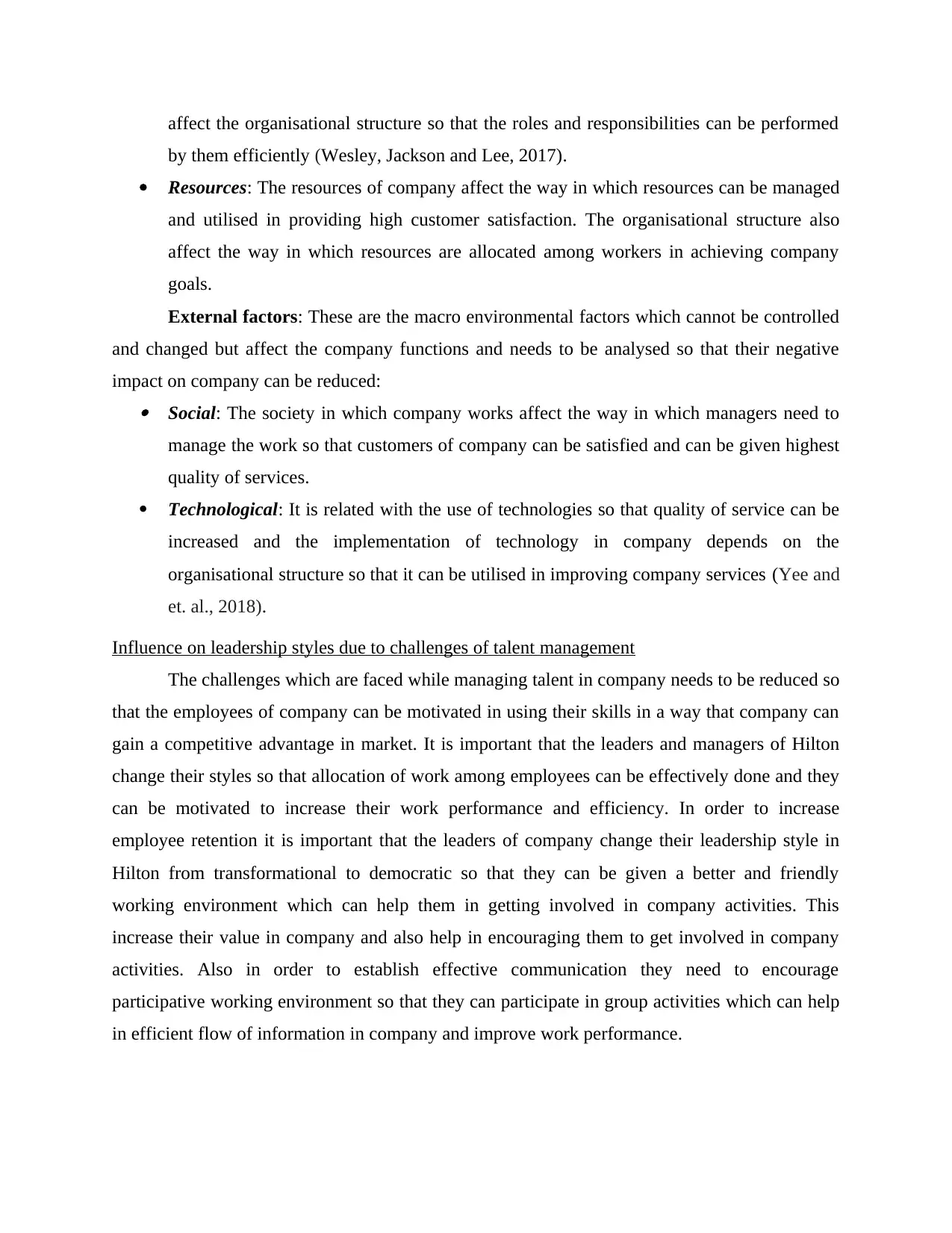
affect the organisational structure so that the roles and responsibilities can be performed
by them efficiently (Wesley, Jackson and Lee, 2017).
Resources: The resources of company affect the way in which resources can be managed
and utilised in providing high customer satisfaction. The organisational structure also
affect the way in which resources are allocated among workers in achieving company
goals.
External factors: These are the macro environmental factors which cannot be controlled
and changed but affect the company functions and needs to be analysed so that their negative
impact on company can be reduced: Social: The society in which company works affect the way in which managers need to
manage the work so that customers of company can be satisfied and can be given highest
quality of services.
Technological: It is related with the use of technologies so that quality of service can be
increased and the implementation of technology in company depends on the
organisational structure so that it can be utilised in improving company services (Yee and
et. al., 2018).
Influence on leadership styles due to challenges of talent management
The challenges which are faced while managing talent in company needs to be reduced so
that the employees of company can be motivated in using their skills in a way that company can
gain a competitive advantage in market. It is important that the leaders and managers of Hilton
change their styles so that allocation of work among employees can be effectively done and they
can be motivated to increase their work performance and efficiency. In order to increase
employee retention it is important that the leaders of company change their leadership style in
Hilton from transformational to democratic so that they can be given a better and friendly
working environment which can help them in getting involved in company activities. This
increase their value in company and also help in encouraging them to get involved in company
activities. Also in order to establish effective communication they need to encourage
participative working environment so that they can participate in group activities which can help
in efficient flow of information in company and improve work performance.
by them efficiently (Wesley, Jackson and Lee, 2017).
Resources: The resources of company affect the way in which resources can be managed
and utilised in providing high customer satisfaction. The organisational structure also
affect the way in which resources are allocated among workers in achieving company
goals.
External factors: These are the macro environmental factors which cannot be controlled
and changed but affect the company functions and needs to be analysed so that their negative
impact on company can be reduced: Social: The society in which company works affect the way in which managers need to
manage the work so that customers of company can be satisfied and can be given highest
quality of services.
Technological: It is related with the use of technologies so that quality of service can be
increased and the implementation of technology in company depends on the
organisational structure so that it can be utilised in improving company services (Yee and
et. al., 2018).
Influence on leadership styles due to challenges of talent management
The challenges which are faced while managing talent in company needs to be reduced so
that the employees of company can be motivated in using their skills in a way that company can
gain a competitive advantage in market. It is important that the leaders and managers of Hilton
change their styles so that allocation of work among employees can be effectively done and they
can be motivated to increase their work performance and efficiency. In order to increase
employee retention it is important that the leaders of company change their leadership style in
Hilton from transformational to democratic so that they can be given a better and friendly
working environment which can help them in getting involved in company activities. This
increase their value in company and also help in encouraging them to get involved in company
activities. Also in order to establish effective communication they need to encourage
participative working environment so that they can participate in group activities which can help
in efficient flow of information in company and improve work performance.
Paraphrase This Document
Need a fresh take? Get an instant paraphrase of this document with our AI Paraphraser
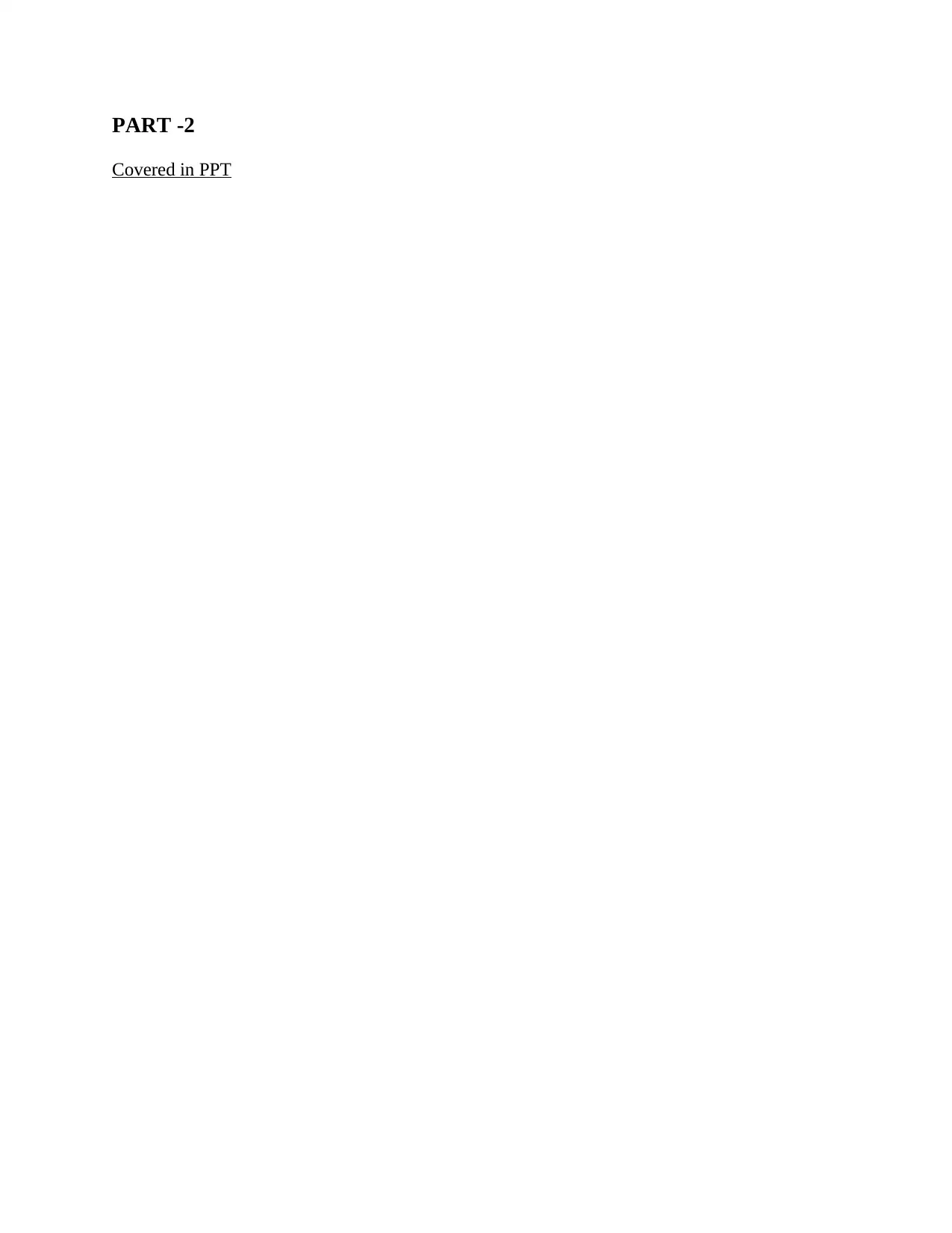
PART -2
Covered in PPT
Covered in PPT
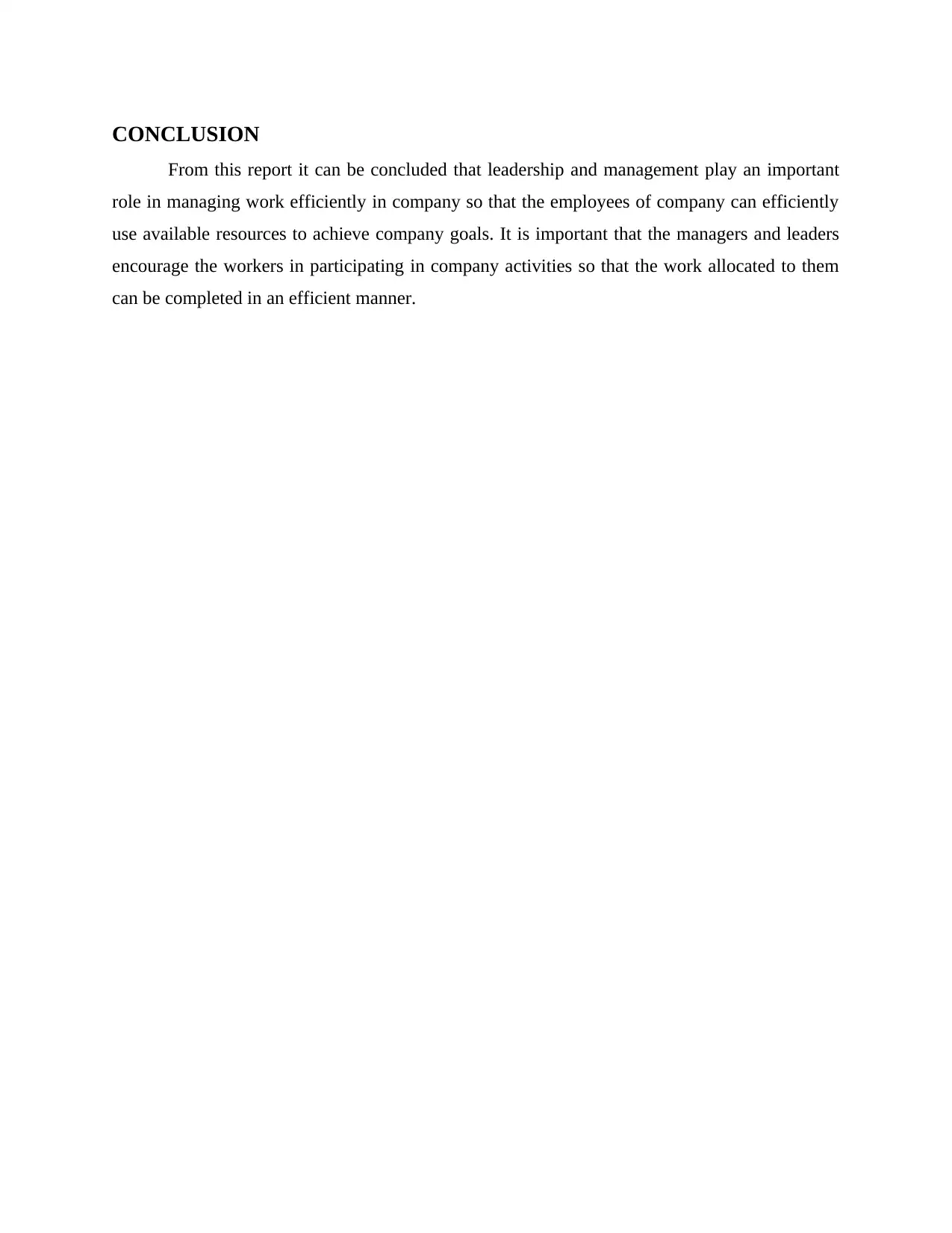
CONCLUSION
From this report it can be concluded that leadership and management play an important
role in managing work efficiently in company so that the employees of company can efficiently
use available resources to achieve company goals. It is important that the managers and leaders
encourage the workers in participating in company activities so that the work allocated to them
can be completed in an efficient manner.
From this report it can be concluded that leadership and management play an important
role in managing work efficiently in company so that the employees of company can efficiently
use available resources to achieve company goals. It is important that the managers and leaders
encourage the workers in participating in company activities so that the work allocated to them
can be completed in an efficient manner.
⊘ This is a preview!⊘
Do you want full access?
Subscribe today to unlock all pages.

Trusted by 1+ million students worldwide
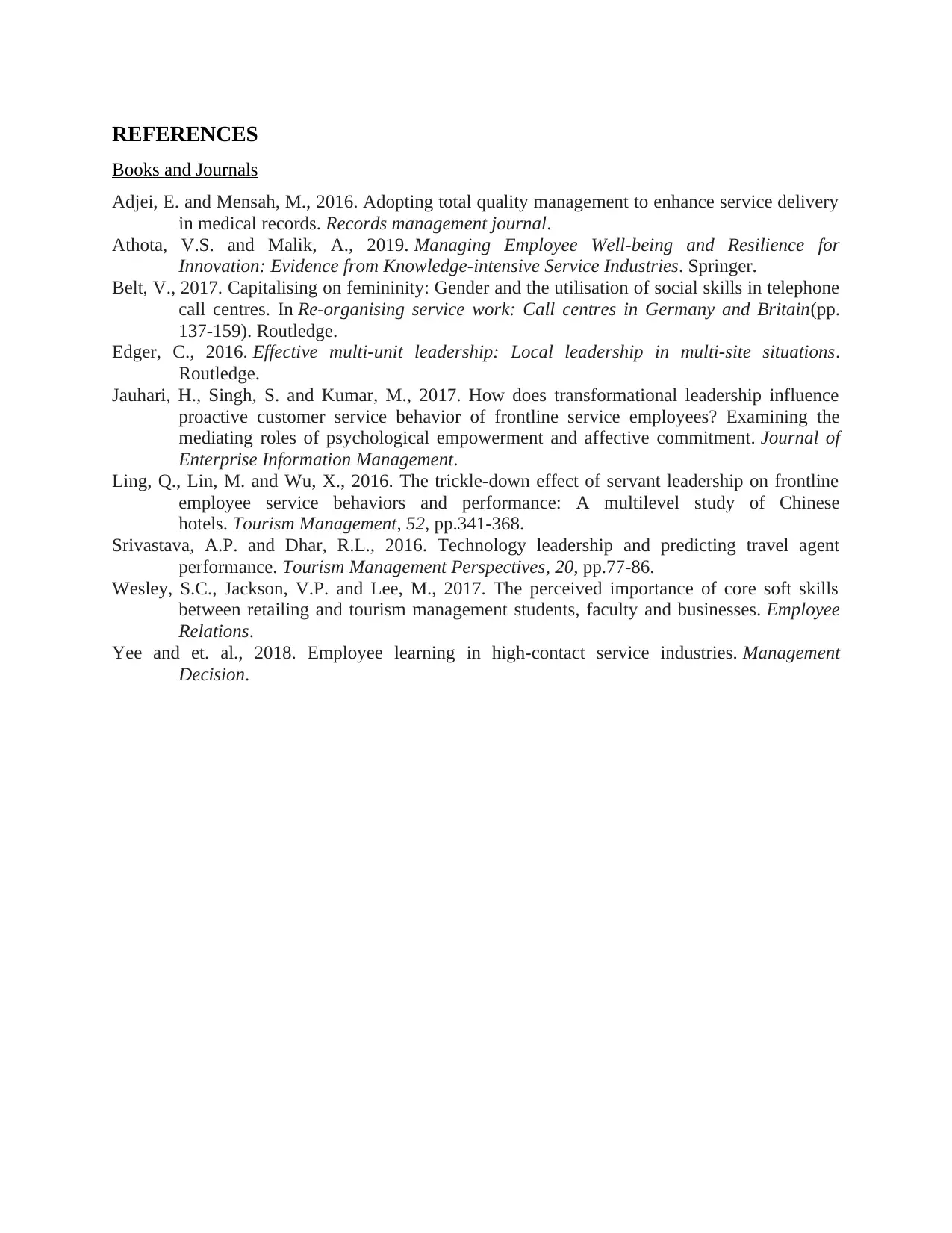
REFERENCES
Books and Journals
Adjei, E. and Mensah, M., 2016. Adopting total quality management to enhance service delivery
in medical records. Records management journal.
Athota, V.S. and Malik, A., 2019. Managing Employee Well-being and Resilience for
Innovation: Evidence from Knowledge-intensive Service Industries. Springer.
Belt, V., 2017. Capitalising on femininity: Gender and the utilisation of social skills in telephone
call centres. In Re-organising service work: Call centres in Germany and Britain(pp.
137-159). Routledge.
Edger, C., 2016. Effective multi-unit leadership: Local leadership in multi-site situations.
Routledge.
Jauhari, H., Singh, S. and Kumar, M., 2017. How does transformational leadership influence
proactive customer service behavior of frontline service employees? Examining the
mediating roles of psychological empowerment and affective commitment. Journal of
Enterprise Information Management.
Ling, Q., Lin, M. and Wu, X., 2016. The trickle-down effect of servant leadership on frontline
employee service behaviors and performance: A multilevel study of Chinese
hotels. Tourism Management, 52, pp.341-368.
Srivastava, A.P. and Dhar, R.L., 2016. Technology leadership and predicting travel agent
performance. Tourism Management Perspectives, 20, pp.77-86.
Wesley, S.C., Jackson, V.P. and Lee, M., 2017. The perceived importance of core soft skills
between retailing and tourism management students, faculty and businesses. Employee
Relations.
Yee and et. al., 2018. Employee learning in high-contact service industries. Management
Decision.
Books and Journals
Adjei, E. and Mensah, M., 2016. Adopting total quality management to enhance service delivery
in medical records. Records management journal.
Athota, V.S. and Malik, A., 2019. Managing Employee Well-being and Resilience for
Innovation: Evidence from Knowledge-intensive Service Industries. Springer.
Belt, V., 2017. Capitalising on femininity: Gender and the utilisation of social skills in telephone
call centres. In Re-organising service work: Call centres in Germany and Britain(pp.
137-159). Routledge.
Edger, C., 2016. Effective multi-unit leadership: Local leadership in multi-site situations.
Routledge.
Jauhari, H., Singh, S. and Kumar, M., 2017. How does transformational leadership influence
proactive customer service behavior of frontline service employees? Examining the
mediating roles of psychological empowerment and affective commitment. Journal of
Enterprise Information Management.
Ling, Q., Lin, M. and Wu, X., 2016. The trickle-down effect of servant leadership on frontline
employee service behaviors and performance: A multilevel study of Chinese
hotels. Tourism Management, 52, pp.341-368.
Srivastava, A.P. and Dhar, R.L., 2016. Technology leadership and predicting travel agent
performance. Tourism Management Perspectives, 20, pp.77-86.
Wesley, S.C., Jackson, V.P. and Lee, M., 2017. The perceived importance of core soft skills
between retailing and tourism management students, faculty and businesses. Employee
Relations.
Yee and et. al., 2018. Employee learning in high-contact service industries. Management
Decision.
1 out of 10
Related Documents
Your All-in-One AI-Powered Toolkit for Academic Success.
+13062052269
info@desklib.com
Available 24*7 on WhatsApp / Email
![[object Object]](/_next/static/media/star-bottom.7253800d.svg)
Unlock your academic potential
Copyright © 2020–2025 A2Z Services. All Rights Reserved. Developed and managed by ZUCOL.



